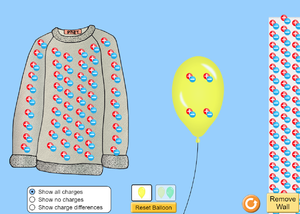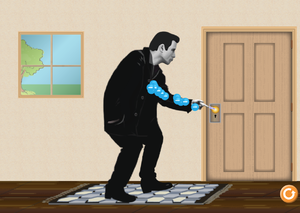Difference between revisions of "Static Electricity"
| (6 intermediate revisions by 2 users not shown) | |||
| Line 4: | Line 4: | ||
===About Static Electricity=== | ===About Static Electricity=== | ||
| − | : '''Static Electricity''' can be caused by rubbing two [[Electrical Insulator|insulators]] together. | + | : '''Static Electricity''' can be caused by rubbing two [[Electrical Insulator|insulators]] together. |
| − | : | + | : [[Friction]] causes [[electron]]s to be transferred from one [[material]] to another. |
| − | : | + | : The [[material]] that gains [[electron]]s becomes [[Negative Charge|negatively charged]]. |
| + | : The [[material]] which loses [[electron]]s becomes [[Positive Charge|positively charged]]. | ||
: Once a [[material]] has become '''statically charged''' it will [[repel]] anything with the same [[Electrical Charge|charge]] and [[attract]] anything with the opposite [[Electrical Charge|charge]]. This happens due to the [[Electrostatic Force|electrostatic force]]. | : Once a [[material]] has become '''statically charged''' it will [[repel]] anything with the same [[Electrical Charge|charge]] and [[attract]] anything with the opposite [[Electrical Charge|charge]]. This happens due to the [[Electrostatic Force|electrostatic force]]. | ||
: [[Lightning]] is caused by a build up of '''static electricity''' in which clouds gain [[electron]]s from the ground. The [[Electrical Charge|charge]] builds up until the [[Electrostatic Force|electrostatic force]] is so large that the [[electron]]s are able to jump to the ground as a bolt of [[lightning]]. | : [[Lightning]] is caused by a build up of '''static electricity''' in which clouds gain [[electron]]s from the ground. The [[Electrical Charge|charge]] builds up until the [[Electrostatic Force|electrostatic force]] is so large that the [[electron]]s are able to jump to the ground as a bolt of [[lightning]]. | ||
| Line 15: | Line 16: | ||
|[[File:PhetTravoltage.png|centre|300px|link=https://phet.colorado.edu/sims/html/john-travoltage/latest/john-travoltage_en.html]] | |[[File:PhetTravoltage.png|centre|300px|link=https://phet.colorado.edu/sims/html/john-travoltage/latest/john-travoltage_en.html]] | ||
|} | |} | ||
| + | |||
| + | ===Extra Information=== | ||
| + | {{#ev:youtube|https://www.youtube.com/watch?v=yc2-363MIQs}} | ||
==Key Stage 4== | ==Key Stage 4== | ||
| Line 21: | Line 25: | ||
===About Static Electricity=== | ===About Static Electricity=== | ||
| − | : '''Static Electricity''' can be caused by rubbing two [[Electrical Insulator|insulators]] together. | + | : '''Static Electricity''' can be caused by rubbing two [[Electrical Insulator|insulators]] together. |
| − | : | + | : [[Friction]] causes [[electron]]s to be transferred from one [[material]] to another. |
| − | : | + | : The [[material]] that gains [[electron]]s becomes [[Negative Charge|negatively charged]]. |
| − | : Once a [[material]] has become '''statically charged''' it will [[repel]] anything with the same [[Electrical Charge|charge]] and [[attract]] anything with the opposite [[Electrical Charge|charge]]. This happens due to the [[Electrostatic Force|electrostatic force]]. | + | : The [[material]] which loses [[electron]]s becomes [[Positive Charge|positively charged]]. |
| + | : Once a [[material]] has become '''statically charged''' it will [[repel]] anything with the same [[Electrical Charge|charge]] and [[attract]] anything with the opposite [[Electrical Charge|charge]]. This happens due to the [[Electrostatic Force|electrostatic force]] which acts at a distance. | ||
: [[Lightning]] is caused by a build up of '''static electricity''' in which clouds gain [[electron]]s from the ground. The [[Electrical Charge|charge]] builds up until the [[Electrostatic Force|electrostatic force]] is so large that the [[electron]]s are able to jump to the ground as a bolt of [[lightning]]. | : [[Lightning]] is caused by a build up of '''static electricity''' in which clouds gain [[electron]]s from the ground. The [[Electrical Charge|charge]] builds up until the [[Electrostatic Force|electrostatic force]] is so large that the [[electron]]s are able to jump to the ground as a bolt of [[lightning]]. | ||
| + | : A '''static charge''' can also be [[Electrostatic Induction|induced]] in a [[Neutral Charge|neutral]] [[object]]. This happens when a [[Electrical Charge|charged]] [[object]] is placed close to a [[Neutral Charge|neutral]] [[object]]. Since the [[electron]]s in the [[Neutral Charge|neutral]] [[object]] can move then they move towards a [[Positive Charge|positive charge]] and away from a [[Negative Charge|negative charge]]. This allows the [[Neutral Charge|neutral]] [[object]] to become slightly [[Electrical Charge|charged]] at one side. This is [[Electrostatic Induction|electrostatic induction]]. | ||
To learn more about [[Static Electricity]] click on each of the picture below for a PHET simulation. | To learn more about [[Static Electricity]] click on each of the picture below for a PHET simulation. | ||
| Line 32: | Line 38: | ||
|[[File:PhetTravoltage.png|centre|300px|link=https://phet.colorado.edu/sims/html/john-travoltage/latest/john-travoltage_en.html]] | |[[File:PhetTravoltage.png|centre|300px|link=https://phet.colorado.edu/sims/html/john-travoltage/latest/john-travoltage_en.html]] | ||
|} | |} | ||
| + | |||
| + | ===References=== | ||
| + | ====AQA==== | ||
| + | |||
| + | :[https://www.amazon.co.uk/gp/product/178294558X/ref=as_li_tl?ie=UTF8&camp=1634&creative=6738&creativeASIN=178294558X&linkCode=as2&tag=nrjc-21&linkId=f0dfb66dafcb0c6e9449e7b1a4ae1ac429 ''Static electricity, page 35, GCSE Physics; The Revision Guide, CGP, AQA ''] | ||
| + | :[https://www.amazon.co.uk/gp/product/0008158770/ref=as_li_tl?ie=UTF8&camp=1634&creative=6738&creativeASIN=0008158770&linkCode=as2&tag=nrjc-21&linkId=ec31595e720e1529e49876c3866fff6e ''Static electricity, pages 46-9, GCSE Physics; Student Book, Collins, AQA ''] | ||
| + | :[https://www.amazon.co.uk/gp/product/1471851370/ref=as_li_tl?ie=UTF8&camp=1634&creative=6738&creativeASIN=1471851370&linkCode=as2&tag=nrjc-21&linkId=01c69b0ae058f809cf636033e6ba793e ''Static electricity, pages 56-7, GCSE Physics, Hodder, AQA ''] | ||
| + | :[https://www.amazon.co.uk/gp/product/1782945970/ref=as_li_tl?ie=UTF8&camp=1634&creative=6738&creativeASIN=1782945970&linkCode=as2&tag=nrjc-21&linkId=a120d24dcc7cc7a58192069a3aafc1d2 ''Static electricity, pages 99-101, GCSE Physics; The Complete 9-1 Course for AQA, CGP, AQA ''] | ||
| + | |||
| + | ====Edexcel==== | ||
| + | |||
| + | :[https://www.amazon.co.uk/gp/product/1292120223/ref=as_li_tl?ie=UTF8&camp=1634&creative=6738&creativeASIN=1292120223&linkCode=as2&tag=nrjc-21&linkId=068ecf40278c32406a7f1c6e66751417 ''Static electricity, pages 133, 160-161, GCSE Physics, Pearson Edexcel ''] | ||
| + | :[https://www.amazon.co.uk/gp/product/1782948163/ref=as_li_tl?ie=UTF8&camp=1634&creative=6738&creativeASIN=1782948163&linkCode=as2&tag=nrjc-21&linkId=0fdbfd5dd397d6e24a9dfb250f08587f ''Static electricity, pages 254-261, GCSE Physics, CGP, Edexcel ''] | ||
| + | :[https://www.amazon.co.uk/gp/product/1782945733/ref=as_li_tl?ie=UTF8&camp=1634&creative=6738&creativeASIN=1782945733&linkCode=as2&tag=nrjc-21&linkId=2a2dbec9db6bf5766c0458d908fa0a52 ''Static electricity, pages 82-84, GCSE Physics; The Revision Guide, CGP, Edexcel ''] | ||
| + | :[https://www.amazon.co.uk/gp/product/1292120223/ref=as_li_tl?ie=UTF8&camp=1634&creative=6738&creativeASIN=1292120223&linkCode=as2&tag=nrjc-21&linkId=068ecf40278c32406a7f1c6e66751417 ''Static electricity; dangers, pages 162-163, GCSE Physics, Pearson Edexcel ''] | ||
| + | :[https://www.amazon.co.uk/gp/product/1782948163/ref=as_li_tl?ie=UTF8&camp=1634&creative=6738&creativeASIN=1782948163&linkCode=as2&tag=nrjc-21&linkId=0fdbfd5dd397d6e24a9dfb250f08587f ''Static electricity; dangers, pages 260, 261, GCSE Physics, CGP, Edexcel ''] | ||
| + | :[https://www.amazon.co.uk/gp/product/1292120223/ref=as_li_tl?ie=UTF8&camp=1634&creative=6738&creativeASIN=1292120223&linkCode=as2&tag=nrjc-21&linkId=068ecf40278c32406a7f1c6e66751417 ''Static electricity; uses, page 163, GCSE Physics, Pearson Edexcel ''] | ||
| + | :[https://www.amazon.co.uk/gp/product/1782948163/ref=as_li_tl?ie=UTF8&camp=1634&creative=6738&creativeASIN=1782948163&linkCode=as2&tag=nrjc-21&linkId=0fdbfd5dd397d6e24a9dfb250f08587f ''Static electricity; uses, pages 258, 259, GCSE Physics, CGP, Edexcel ''] | ||
| + | |||
| + | ====OCR==== | ||
| + | :[https://www.amazon.co.uk/gp/product/1782945695/ref=as_li_tl?ie=UTF8&camp=1634&creative=6738&creativeASIN=1782945695&linkCode=as2&tag=nrjc-21&linkId=ceafcc80bcad6b6754ee97a0c7ceea53 ''Static electricity, page 175, Gateway GCSE Combined Science; The Revision Guide, CGP, OCR ''] | ||
| + | :[https://www.amazon.co.uk/gp/product/1782945687/ref=as_li_tl?ie=UTF8&camp=1634&creative=6738&creativeASIN=1782945687&linkCode=as2&tag=nrjc-21&linkId=9a598e52189317a20311d7a632747bc9 ''Static electricity, page 42, Gateway GCSE Physics; The Revision Guide, CGP, OCR ''] | ||
| + | :[https://www.amazon.co.uk/gp/product/0198359837/ref=as_li_tl?ie=UTF8&camp=1634&creative=6738&creativeASIN=0198359837&linkCode=as2&tag=nrjc-21&linkId=3c4229e8b023b2b60768e7ea2307cc6f ''Static electricity, pages 94-95, Gateway GCSE Physics, Oxford, OCR ''] | ||
Latest revision as of 12:14, 20 December 2019
Contents
Key Stage 3
Meaning
Static Electricity is an imbalance of charges that causes a force which can attract or repel other objects.
About Static Electricity
- Static Electricity can be caused by rubbing two insulators together.
- Friction causes electrons to be transferred from one material to another.
- The material that gains electrons becomes negatively charged.
- The material which loses electrons becomes positively charged.
- Once a material has become statically charged it will repel anything with the same charge and attract anything with the opposite charge. This happens due to the electrostatic force.
- Lightning is caused by a build up of static electricity in which clouds gain electrons from the ground. The charge builds up until the electrostatic force is so large that the electrons are able to jump to the ground as a bolt of lightning.
To learn more about Static Electricity click on each of the picture below for a PHET simulation.
Extra Information
Key Stage 4
Meaning
Static Electricity is an imbalance of charges that causes a force which can attract or repel other objects.
About Static Electricity
- Static Electricity can be caused by rubbing two insulators together.
- Friction causes electrons to be transferred from one material to another.
- The material that gains electrons becomes negatively charged.
- The material which loses electrons becomes positively charged.
- Once a material has become statically charged it will repel anything with the same charge and attract anything with the opposite charge. This happens due to the electrostatic force which acts at a distance.
- Lightning is caused by a build up of static electricity in which clouds gain electrons from the ground. The charge builds up until the electrostatic force is so large that the electrons are able to jump to the ground as a bolt of lightning.
- A static charge can also be induced in a neutral object. This happens when a charged object is placed close to a neutral object. Since the electrons in the neutral object can move then they move towards a positive charge and away from a negative charge. This allows the neutral object to become slightly charged at one side. This is electrostatic induction.
To learn more about Static Electricity click on each of the picture below for a PHET simulation.
References
AQA
- Static electricity, page 35, GCSE Physics; The Revision Guide, CGP, AQA
- Static electricity, pages 46-9, GCSE Physics; Student Book, Collins, AQA
- Static electricity, pages 56-7, GCSE Physics, Hodder, AQA
- Static electricity, pages 99-101, GCSE Physics; The Complete 9-1 Course for AQA, CGP, AQA
Edexcel
- Static electricity, pages 133, 160-161, GCSE Physics, Pearson Edexcel
- Static electricity, pages 254-261, GCSE Physics, CGP, Edexcel
- Static electricity, pages 82-84, GCSE Physics; The Revision Guide, CGP, Edexcel
- Static electricity; dangers, pages 162-163, GCSE Physics, Pearson Edexcel
- Static electricity; dangers, pages 260, 261, GCSE Physics, CGP, Edexcel
- Static electricity; uses, page 163, GCSE Physics, Pearson Edexcel
- Static electricity; uses, pages 258, 259, GCSE Physics, CGP, Edexcel

